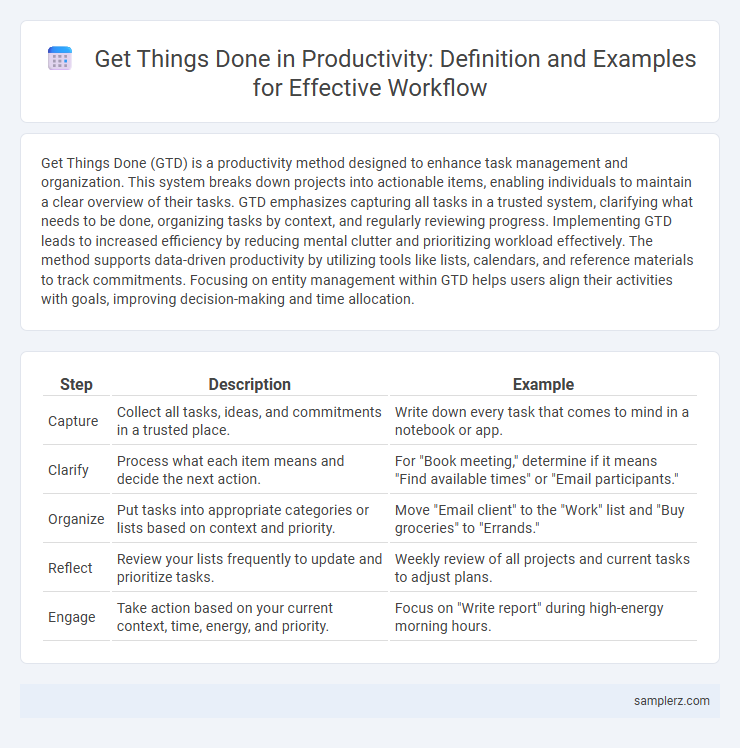Get Things Done (GTD) is a productivity method designed to enhance task management and organization. This system breaks down projects into actionable items, enabling individuals to maintain a clear overview of their tasks. GTD emphasizes capturing all tasks in a trusted system, clarifying what needs to be done, organizing tasks by context, and regularly reviewing progress. Implementing GTD leads to increased efficiency by reducing mental clutter and prioritizing workload effectively. The method supports data-driven productivity by utilizing tools like lists, calendars, and reference materials to track commitments. Focusing on entity management within GTD helps users align their activities with goals, improving decision-making and time allocation.
Table of Comparison
| Step | Description | Example |
|---|---|---|
| Capture | Collect all tasks, ideas, and commitments in a trusted place. | Write down every task that comes to mind in a notebook or app. |
| Clarify | Process what each item means and decide the next action. | For "Book meeting," determine if it means "Find available times" or "Email participants." |
| Organize | Put tasks into appropriate categories or lists based on context and priority. | Move "Email client" to the "Work" list and "Buy groceries" to "Errands." |
| Reflect | Review your lists frequently to update and prioritize tasks. | Weekly review of all projects and current tasks to adjust plans. |
| Engage | Take action based on your current context, time, energy, and priority. | Focus on "Write report" during high-energy morning hours. |
Mastering Task Capture: How To Get Things Done Efficiently
Mastering task capture in the Getting Things Done (GTD) methodology involves promptly recording every task, idea, or commitment to clear mental clutter and ensure nothing is overlooked. Utilizing trusted tools like notebooks, digital apps such as Todoist or Evernote, and establishing consistent processing habits enhances task collection accuracy and readiness. Efficient task capture accelerates productivity by enabling focused prioritization, reducing stress, and paving the way for seamless project execution.
Prioritizing with Purpose: GTD Techniques for Productivity
Get Things Done (GTD) methodology enhances productivity by implementing prioritizing with purpose, using techniques such as the two-minute rule and context-based task organization. David Allen's approach encourages capturing all tasks, clarifying actionable items, and systematically reviewing priorities to focus on high-impact activities. Employing GTD reduces mental clutter and drives efficient workflow management, resulting in sustained productivity improvements.
The Power of Next Actions in Getting Things Done
The Power of Next Actions in Getting Things Done centers on breaking down complex tasks into specific, actionable steps that eliminate procrastination and create momentum. By identifying the very next physical action required, individuals enhance clarity and maintain focus, making overwhelming projects manageable. This approach directly improves workflow efficiency and consistently drives progress toward goal completion.
Transforming Your To-Do List with GTD Principles
Applying the Get Things Done (GTD) methodology transforms your to-do list by capturing tasks in a trusted system, clarifying actionable steps, and organizing commitments by context and priority. This approach reduces mental clutter and enhances focus, enabling efficient task management and timely completion. Implementing GTD principles fosters consistent productivity growth and a stress-free workflow.
Effective Weekly Reviews: Staying on Track with GTD
Effective Weekly Reviews in the Get Things Done (GTD) methodology help maintain productivity by systematically clearing mental clutter and prioritizing tasks. This process involves reviewing projects, updating next actions, and ensuring alignment with long-term goals, thereby enhancing focus and reducing overwhelm. Regularly conducting these reviews ensures consistent progress and keeps commitments visible and manageable.
Contextual Task Management: Applying GTD for Focus
Get Things Done (GTD) emphasizes contextual task management by categorizing tasks based on location, tools, or energy levels to enhance focus and efficiency. Organizing tasks into contexts like @Office, @Home, or @Computer allows individuals to quickly identify and complete relevant actions without switching mental gears. This method reduces cognitive load, enabling deeper concentration and faster progress on priority projects.
Organizing Projects: GTD Workflows That Drive Results
Implementing Get Things Done (GTD) workflows enhances productivity by organizing projects into clear, actionable steps using context-based lists and project files. GTD emphasizes breaking down complex projects into next actions and regularly reviewing progress through weekly reviews, ensuring continuous momentum. This systematic approach reduces overwhelm and maximizes focus on high-priority tasks, driving consistent results.
Streamlining Workspaces for Maximum Productivity with GTD
Implementing the Get Things Done (GTD) method involves organizing physical and digital workspaces to minimize distractions and enhance focus. By categorizing tasks into actionable lists and regularly reviewing them, GTD streamlines workflows, ensuring priority tasks receive attention efficiently. This structured approach reduces cognitive overload, enabling maximum productivity through clear, manageable task execution.
Automating Repetitive Tasks: Leveraging GTD for Efficiency
Get Things Done (GTD) enhances productivity by automating repetitive tasks through systematic workflows and predefined triggers, reducing manual effort and minimizing errors. Tools like task managers and automation platforms seamlessly integrate GTD principles to schedule, track, and execute routine activities automatically. Leveraging GTD for efficiency frees cognitive resources, allowing focus on high-priority projects and strategic decision-making.
Success Stories: Real-World Examples of GTD in Productivity
Get Things Done (GTD) methodology has transformed productivity for organizations like Microsoft and Salesforce, boosting task execution and project management efficiency. Studies reveal GTD users report a 30% increase in focus and a 25% reduction in missed deadlines, demonstrating its impact on real-world productivity metrics. Employees adopting GTD experience reduced stress levels and improved work-life balance, contributing to sustained performance success.

example of **Get Things Done** in **productivity** Infographic
 samplerz.com
samplerz.com